#ancient greek calendars
Explore tagged Tumblr posts
Text
Calendar manipulation in Ancient Greece
This really isn’t a topic I’m thrilled to tackle, but since the Theogamia there has been so much talk about calendar discrepancies that it looks like the right time to bring this up. Don’t expect this to be eloquent, I’m writing this while absolutely knackered.
I’m not going to focus too much on the problem of modern calendar reconstructions, what I’ll be going into here is the historical evidence we have about how awfully inconsistent the ancient Athenian calendar could be, either by nature or by human intervention over time.
The problem of the new moon
In theory, the Athenian calendar and other Greek calendars are lunar and each month begins on the new moon. Sacha Stern, in Calendars in Antiquity, tells us that the writer Geminus (1st c. BCE), states that the Greek month began when the new moon crescent was first sighted but Geminus also states that the new moon can sometimes be sighted on the 1st of the month, but sometimes not until the 3rd. This statement is interesting, because it implies that, should the moon not be visible (clouds), there was a mathematical basis to the calculation of the months that still made the month begin regardless of what the sky looked like.
There comes also the problem of conjunction (aka when the moon in orbit passes between the sun and the earth, making the moon invisible). The traditional ancient assumption is that the day of conjunction is the last day of the month. However, the interval between the day of conjunction and of the new moon is usually around two days; so if the month began when the new moon was first sighted, conjunction should have been typically on the penultimate day of the previous month.
Those difficulties, along the fact that other authors, such as Aratus give conflicting information leads Stern to say this:
Modern scholars have generally accepted Geminus’ statements that the Greek month began at first visibility of the new moon. However, it is clear on Geminus’ own evidence, as well as on the evidence of the other passages just mentioned, that this rule was not strictly followed, and indeed, quite possibly, that it did not constitute a rule. Moreover, we do not know of any procedure that may have been used, and indeed that would have been necessary, for such a rule to be enforced. There is no evidence, for example, in the whole of Graeco-Roman literature of anyone sighting the new moon.
And this leads us to the rather uncomfortable idea that, in practice, a lot of the calendars simply might not have been as well aligned with astronomical moon phases in the way we conceptualize it today.
Francis M. Dunn, in an article titled Tampering with the Calendar, lists passages from ancient Greek sources that seem to corroborate this idea:
Thucydides 2.28 in a passing mention of a solar eclipse […] distinguishes the astronomical "new moon" or conjunction, at which eclipses must occur, from the conventional "new moon" or noumenia, which followed the first visible crescent. The historian, in other words, is aware that there is an astronomical "new moon" or conjunction which is different from the first day of the civic month.
Man-made adjustments
Because calendars impacted the religious, civic and political lives of each city-states, it wasn’t uncommon for city-states to make adjustments to them.
The type of modification we’re most used to is the addition of intercalary days or month that aim to realign the calendar with astronomical reality. But we have evidence that this isn’t the only motivation.
For example:
In the 430's (SEG XXXVI 12), 420's (SEG XL 12) or 410's (SEG XLII 17), in connection with offerings at Eleusis, the demos instructed the archon to add a second Hekatombaion.
In 228/7 a second Hekatombaion was added to the civic calendar.
Between 294 and 288, in connection with a tour by artists of Dionysus during Lenaion, four cities in Euboea made provision for the archons to add months as necessary.
At the end of the fourth century, probably in 307/6, two days were apparently added near the end of Gamelion.
In 271/0 four days were added in the first decade of Elaphebolion.
As we can see, additions and subtractions of one or several days, if not sometimes months, could happen. They were often added either at the beginning of a month or at the end of a month, which makes it easier to imagine that it could be done to readjust the calendar to the moon, but in the cases where it was linked to a festival, it was clearly done to schedule said festival:
”Of the three cases of intercalary months, two are explicitly related to religious festivals (the dedication of first fruits at Eleusis, IG I3 78; and dramatic festivals in Euboea, IG xii.9 207”
“The evidence therefore supports an assumption that most adjustments were part of the normal operation of the civic calendar - ensuring that the calendar was roughly in phase with sun and moon, and ensuring that festivals would take place at a necessary or convenient time.”
An insoluble debate
The problem of ancient Greek calendars as a whole has been a point of contention among scholars for so long, for the simple reason that it makes dating anything difficult. The most notable example is the one around the differences between the Athenian calendar and the Spartan one when it comes to dating something like the battle of Marathon. Plutarch tells us it was on the 6th of Boedromion, but Herodotus tells us it was during the full moon (and therefore later, if the calendars matched the lunar cycle). This is where the issue of inter-city calendar alignment emerges, since each city-state functioned in their own independent ways, they could resort to calendar adjustments at any time they wanted and further misaligning themselves with one another.
But scholars don’t necessarily agree! Some, like Pritchett believed that the calendars were irregular no matter what, while others like Meritt believed they were regular, and that the evidence of irregularity was due to exceptional circumstances. The problem at this point is that it is much harder to prove regularity than the opposite.
So where does it leave us?
The reconstructed calendars we use today as modern worshippers are all based on some form of regularity, but we need to remember that none of them are a direct continuation of the ancient calendars. For the most part, they are based on the metonic cycle and on the other luni-solar calendars in use today by various faiths and cultures around the world. In fact, a lot of the reconstructions of Athenian calendars are using the same mathematical model as the Hebrew calendar. And that, in a nutshell, explains why different reconstruction have different results when it comes to placing specific days and festivals. So it really comes down to personal choice. Choosing a calendar that is more “popular” might be more appealing to you for particular reasons, while others might choose their calendar based on entirely different criteria. I guess the point I’m trying to get to is that, there won’t be a “standard” calendar without some kind of wide decision to stick to a precise model, and as long as there is no religious authority, the calendars will remain ever so slightly different, because they never really were regular in the way that we understand our solar Gregorian calendar to be.
91 notes
·
View notes
Text

In today's 9 door, we delve into the world of greek mythology. We sail with the Penteconter Argo in search of the Golden Fleece.


The Argo is a replica of the legendary ship on which Jason and his Argonauts braved fearsome creatures and other dangers in their search for the Golden Fleece. The replica ship set sail from Jason's home town of Volos in central Greece on 14 June 2008, propelled by 50 oarsmen. On its 2,000 nautical miles (just over 3,700 kilometres) journey, which ends in the Italian port of Venice on 11 August, the ship will drop anchor in a total of 23 cities. An original plan for the Argo to sail to the Black Sea region like its ancient namesake was scrapped after Turkey refused to guarantee the ship safe passage through the Bosporus.
Today she lies ashore, waiting to be placed in a museum.
107 notes
·
View notes
Text



🌿🏺My 2024 Saturnalia Shop is live! 🏺🌿
I am stocking favourites from last year, like my Epic Trilogy Bookmarks and foiled Roman Gods stickers, as well as 2025 calendars, two new A5 notepads, and a new Saturnalia card design! 🧡
Shop link: shop.flarohillustration.com
#tagamemnon#flaroh illustration#greek mythology#ancient greece#hellenic pagan#greek myth art#argh sorry I’ve been awful at keeping my tumblr up to date#stationary#wlw#for the calendars lol#college#university#illustration
62 notes
·
View notes
Text
valgrace bday week
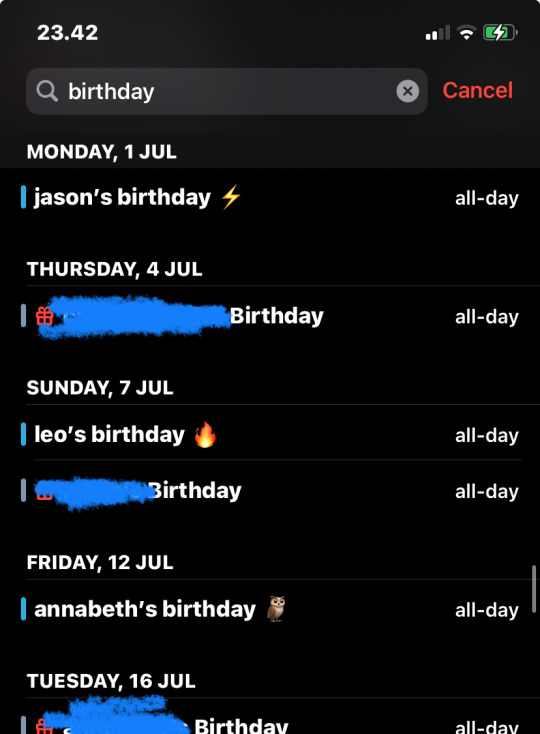
#who dosent have fictional ppls bdays in their calendars anyway!!#julys first week starts with jasons birthday and ends with leos#and the following friday is annabeth’s birthday!!!#honestly i love valgrace so much platonically#ᝰ fay [ft. voices in head] .ᐟ#pjo#pjo hoo toa#hoo#heroes of olympus#leo valdez#jason grace#annabeth chase#percy jackson#perseus jackson#rick riordan#percy jackson and the olympians#ancient greek mythology#the heroes of olympus#trials of apollo#the trials of apollo#rrverse#riordanverse#rick riordan universe#chb#cj#camp half blood#camp half-blood#camp jupiter#july#calendar
69 notes
·
View notes
Text
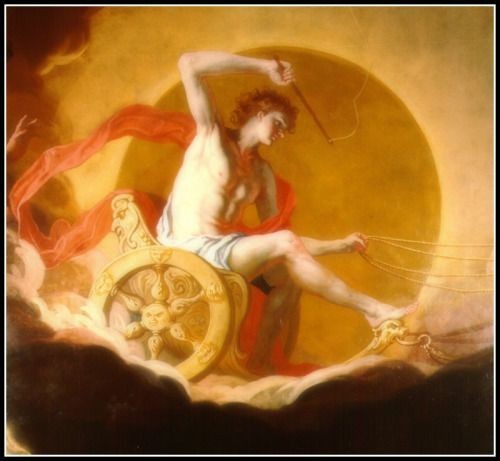
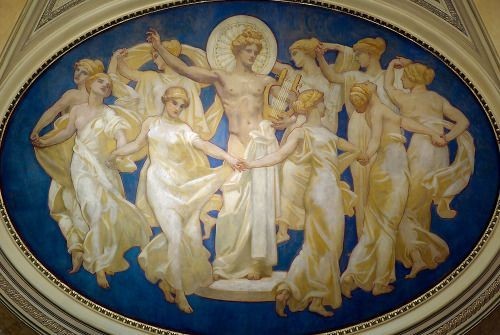
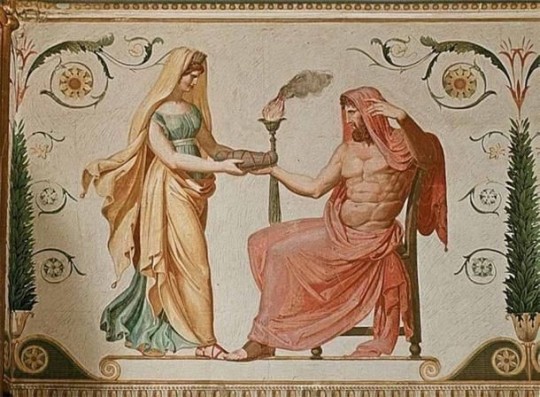
9 Metageitniōn| Μεταγειτνιών (Attic Calendar) - 14th of August/ 20th-24th of August
Helios (Ἡλιος), The Muses (Μουσαι) and Rhea (Ρεια, Μητηρ Θεων)
The Muses are: Melpomene the Muse of tragedy held a tragic mask, Thaleia Muse of comedy a comedy mask, Terpiskhore Muse of dance a lyre, Kalliope the Muse of epic poetry a lyre, Kleio the Muse of history a stylus and scroll, Polymnia the Muse of hymns a veil and pensive pose, Ourania the Muse of astronomy a globe, Erato the Muse of erotic poetry a lyre, and Euterpe the Muse of lyric poetry a flute.
Hesiod, Theogony 1 ff (trans. Evelyn-White) (Greek epic C8th or 7th B.C.) :
"Of the Mousai Helikoniades (of Helikon) let us begin to sing, who hold the great and holy mount of Helikon, and dance on soft feet about the deep-blue spring and the altar of the almighty Kronion [Zeus], and, when they have washed their tender bodies in Permessos [stream of Helikon] or in the Hippokrene (Horse's Spring) or Olmeios [stream of Helikon], make their fair, lovely dances upon highest Helikon and move with vigorous feet"

Rhea, Mater Megala
Antoninus Liberalis, Metamorphoses 19 (trans. Celoria) (Greek mythographer C2nd A.D.) :
"In Krete there is said to be a sacred cave full of bees. In it, as storytellers say, Rhea gave birth to Zeus; it is a sacred place an no one is to go near it, whether god or mortal. At the appointed time each year a great blaze is seen to come out of the cave. Their story goes on to say that this happens whenever the blood from the birth of Zeus begins to boil up. The sacred bees that were the nurses of Zeus occupy this cave."

Ἡλιος
HELIOS (Helius) was the Titan god of the sun, a guardian of oaths, and the god of sight. He dwelt in a golden palace in the River Okeanos (Oceanus) at the far ends of the earth from which he emerged each dawn, crowned with the aureole of the sun, driving a chariot drawn by four winged steeds. When he reached the the land of the Hesperides in the far West he descended into a golden cup which bore him through the northern streams of Okeanos back to his rising place in the East.
Homeric Hymn 31 to Helius (trans. Evelyn-White) (Greek epic C7th - 4th B.C.) :
"Glowing Helios (Sun) whom mild-eyed Euryphaessa (Wide Shining), the far-shining one, bare to [Hyperion] the son of Gaia (Gaea, Earth) and starry Ouranos (Uranus, Heaven). For Hyperion wedded glorious Euryphaessa, his own sister, who bare him lovely children, rosy-armed Eos (the Dawn) and rich-tressed Selene (the Moon) and tireless Helios (Helius, the Sun) who is like the deathless gods."
#hellenistic#hellenic deities#hellenic pagan#hellenism#hellenic polytheism#hellenic worship#hellenic calendar#festivals#rhea#helios#the muses#deity#deity work#deity worship#pagan#paganism#paganblr#sources#greek#greek literature#greek deities#greek tumblr#greek mythology#greek gods#greek myth#greek myth art#greek posts#ancient greece#pagan witch#apollo
37 notes
·
View notes
Text

Hey so I made an Alternative Advent Calendar in 2021 with Ancient Greek Mythical Creatures in it. I made some physical copies and then a PDF to download-and-print at home because postage/time.

She got one 😁

I’m making another one this year with Ancient Greek Mythical Women, so I’ve made a fantasy temple version based on the Tholos of Athene outside Delphi and the Tholos temple of Vesta in the House of the Vestals, Rome. I’ve literally be thinking about it for an entire year 😂

Here’s a sly peek at it (uncut).
Is it pretty? I really want it to be pretty.
The old one download-and-print: https://greekmythcomixshop.wordpress.com/2021/11/06/new-ancient-greek-mythological-creatures-advent-calendar/
Also one that you can print blank for classes to colour in: https://greekmythcomixshop.wordpress.com/2021/11/10/new-ancient-greek-colour-in-draw-your-own-mythological-creatures-advent-calendar-teachers-edition/
#alternative advent calendar#ancient Greek advent calendar#greek mythology#tagamemnon#greek myth#illustration#greek myth comix#comix#Ancient Greek mythical women#ancient greek mythology#advent calendar#download and print#teaching resources#classical civilisation#mythical creatures
20 notes
·
View notes
Text
some ancient greek holidays
these holidays follow the lunar/athenian calendar, so I will either be providing the moon phase or Athenian date and the corresponding Gregorian months. also this is pretty obvious but these are just very general descriptions of these holidays, to give you an idea of which you think you'd like to practice. no one is forcing you to do every single one of these, nor is it expected. do whatever works for you.
if there's anything you think I should add, let me know

HEKATE'S DEIPNON
when: during the new moon phase purpose: honor Hekate and the souls of the restless dead, cleanse self and home activities: a meal set out at Hekate's altar (often including garlic, raw eggs, cake, leeks/onions, or fish), a sacrifice (usually of an animal, but it can be your choice), and burning of incense and/or cleaning house as purification deities honored: Hekate, the dead
NOUMENIA
when: the first day a sliver of the moon can be seen purpose: a day of rest and feasting activities: offer frankincense, flower garlands, wine, and barley cakes on the altars that had been cleaned the day before deities honored: household gods like Hestia, Hermes, Hekate and Zeus, celestial deities like Apollo and Artemis, or personal protective deities (like Athena was for Athens)
AGATHOS DAIMON
when: the day after Noumenia purpose: it's personal to each family but is often a ritual to honor the intermediary(ies) between mortals and gods, and to ask for things like good luck or protection activities: wine/other libations, offerings placed on an altar personal to the Agathos Daimon which can include incense, food, and things related to snakes deities honored: deities commonly associated with snakes, like Dionysus and Hermes, as well as the goddess of luck, Tyche, and Zeus, who is often called Agathos Daimon
RURAL DIONYSIA
when: during the month of Poseideon (december/january), but the festivals often happened on different days depending on the place purpose: honoring Dionysus and cultivation activities: a procession of men carrying phalluses, girls carrying baskets of bread, people with water, bread, cakes, and wine). dancing and singing contests, possibly even dramatic performances, and choruses of dithryambs. deities honored: Dionysus
CITY DIONYSIA
when: 10th-17th of Elaphebolion (March/April) purpose: honoring Dionysus activities: a reenactment of Dionysus being rebuffed from Athens, one or several dramas/plays, dramatic competitions, singing and dancing, feasting and offerings (especially of bread or phalluses)/libations (often of wine) deities honored: Dionysus
PANATHANEA
when: 23rd-30th of Hekatombaion (July/August) purpose: celebrating the birth of Athens activities: a huge procession showing off a large tapestry woven by only women, a torch race, a meal of meat for everyone in the city, athletic games deities honored: Athena
THARGELIA
when: 6th (for Artemis) and 7th (for Apollo) of Thargelion (May/June) purpose: celebrating the birthdays of Apollo and Artemis activities: the beating and banishment of an ugly man and woman (as purification, but you could just do the usual cleaning and incense burning) on the 6th. offerings of the first harvests were given to Apollo (but you could just cook a dish and offer part of it), a procession of children carrying a wreath with fruit, honey, wine, oil, and bread along with singing on the 7th. deities honored: Artemis and Apollo
THESMOPHORIA
when: 11th-13th Pyanepsion (October/November) purpose: honoring Demeter's loss of Persephone to the Underworld activities: a procession of women up to a space where men were banned, sexual activity was abstained from, they lived primitively (fasted and sat on a floor of branches), and sacrificed of piglets in the first days. then had feasts and prayed (often for things Demeter could provide, like good harvests or fertility) on the last day deities honored: Demeter and Persephone
DIASIA
when: 23rd of Anthesterion (February/March) purpose: honor Zeus Chthonius activities: solemn but joyful night rites of sacrifices, sheep/pig shaped pastry offerings, feasting, dancing, and hymn chanting deities honored: Zeus
KRONIA
when: 12th of Hekatombaion (July/August) purpose: honor Kronos (and to some extent Rhea) activities: feasting in large groups, where slaves can join their masters at the dinner table. like an early version of Labor Day deities honored: Kronos
THEOGAMIA
when: 27th of Gamelion (January/February) purpose: to celebrate the anniversary of Hera and Zeus' marriage activities: feasting, offerings/libations, and possibly also hosting a person's own marriage deities honored: Hera and Zeus
#hellenic deities#hellenic pagan#hellenic polytheism#hellenic worship#hellenism#helpol#ancient greece#ancient greek#greek gods#chthonic deities#deity#deity work#greek deities#greek mythology#ancient greek mythology#greek history#hellenic polythiest#hellenic paganism#paganblr#paganism#pagan witch#pagan#pagan community#witchblr#witchcraft#polytheist#greek polytheism
599 notes
·
View notes
Text
2024 Rural Dionysia Announcement

Io! The time of the year has come again for the Rural Dionysia!
How to participate
The Rural Dionysia is meant to be a smaller competition than its urban counterpart, as such, we have selected only 3 categories:
Freestyle poetry
Modern hymns
“Complete the fragment”
Freestyle poetry
Your poem can be about any chosen topic (myth, personal experience etc.) in any written format. It doesn't have to be religious in nature.
Modern hymn
An hymn must sing the praises of a deity of your choice. Unlike the "freestyle poetry", your work must be of religious nature to fit in this category.
Complete the Fragment
Each year, we choose a fragment from an Ancient Greek poet to work with. The challenge is that the initial fragment must be included somewhere in your piece in its original order. This means you can fill the gaps however you want, but you can’t switch the order of the words in your piece or remove words from the original fragment.
Here is the fragment selected for this 2024 edition:
Fragment 113 by Alcaeus (trans. David A. Campbell; Loeb 142)
…kiss…(they) began…knowledge…sits…are…mortal
Here is the Greek text for reference. Note that because the word "they" is implied, it will be acceptable to keep or modify this word.

If in doubt for any of these categories, remember that you can check submissions from the previous years to get an idea of how others have done before.
Submitting your piece
Please submit your piece through submissions on this blog. All entries must be tagged for the category they are being submitted to. but you can only choose 1 category per piece and each person may only submit 1 entry per category each year.
Entries must also be tagged for potentially triggering content and squicks. If your entry needs a trigger warning, kindly add them at the end of your submission and we will take care of adding them in. Check the rules below for further information about submissions.
Calendar of the event
Nov. 16: Official announcement and opening of submissions. Dec. 17: Final submission day. Dec. 18: Vote opening. Dec. 25: Vote closing. Dec. 25-26: Announcement of the winners!
No worries though! We will be posting reminders about each step when the time comes.
General rules
Roleplay and fanfic are not acceptable submissions. This is a religious festival, please respect our faith and do not submit an entry if you are roleplaying or writing fanfiction.
Unlike with the City Dionysia, entries do not necessarily have to be about specific deities or Hellenic polytheism except for the “Modern Hymn” category, which has to be dedicated to one or many gods of your choice.
There are no meter restrictions. This is up to the writer.
All stories, myths, and poems must be entered using the submissions button.
All entries must be tagged for the category they are being submitted to. Entries must also be tagged for potentially triggering content and squicks.
An entry may only be submitted to a single category.
Each person may only submit one entry per category each year.
Winners for each category will be decided by popular vote.
Admins of this blog cannot participate, for obvious reasons. As for now, this includes @thegrapeandthefig @verdantlyviolet
Questions about the rules? Check the blog for past answers, your answer might be in there. And if it's not, simply submit an ask. We'll answer in the best delays possible.
#dionysusdeity#hellenismos#hellenic paganism#hellenic polytheism#hellenic gods#country dionysia#hellenic festivals#hellenic pagan#hellenic worship#hellenic revivalism#hellenic reconstructionism
270 notes
·
View notes
Text
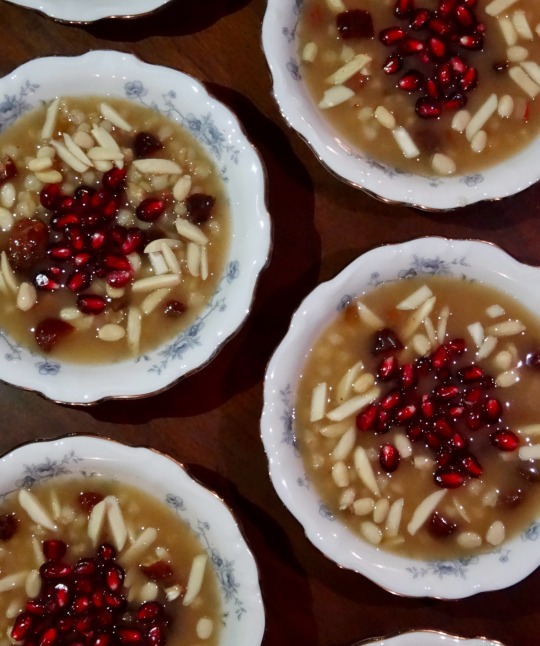

[ID: First image shows four small porcelain bowls of a pudding topped with slivered almonds and pomegranates seeds, seen from above. Second image is an extreme close-up showing the blue floral pattern on the china, slivered almonds, golden raisins, and pomegranate seeds on top of part of the pudding. End ID]
անուշապուր / Anush apur (Armenian wheat dessert)
Anush apur is a sweet boiled wheat pudding, enriched with nuts and dried fruits, that is eaten by Armenians to celebrate special occasions. One legend associates the dish with Noah's Ark: standing on Mt. Ararat (Արարատ լեռը) and seeing the rainbow of God's covenant with humanity, Noah wished to celebrate, and called for a stew to be prepared; because the Ark's stores were diminishing, the stew had to be made with small amounts of many different ingredients.
The consumption of boiled grains is of ancient origin throughout the Levant and elsewhere in West Asia, and so variations of this dish are widespread. The Armenian term is from "անուշ" ("anush") "sweet" + "ապուր" ("apur") "soup," but closely related dishes (or, arguably, versions of the same dish) have many different, overlapping names.
In Arabic, an enriched wheat pudding may be known as "سْنَينِيّة" ("snaynīyya"), presumably from "سِنّ" "sinn" "tooth" and related to the tradition of serving it on the occasion of an infant's teething; "قَمْح مَسْلُوق" ("qamḥ masluq"), "boiled wheat"; or "سَلِيقَة" ("salīqa") or "سَلِيقَة القَمْح" ("salīqa al-qamḥ"), "stew" or "wheat stew," from "سَلَقَ" "salaqa" "to boil." Though these dishes are often related to celebrations and happy occasions, in some places they retain an ancient association with death and funerary rites: qamh masluq is often served at funerals in the Christian town of بَيْت جَالَا ("bayt jālā," Beit Jala, near Bethlehem).
A Lebanese iteration, often made with milk rather than water, is known as "قَمْحِيَّة" ("qamḥīyya," from "qamḥ" "wheat" + "ـِيَّة" "iyya," noun suffix).
A similar dish is known as "بُرْبَارَة" ("burbāra") by Palestinian and Jordanian Christians when eaten to celebrate the feast of Saint Barbara, which falls on the 4th of December (compare Greek "βαρβάρα" "varvára"). It may be garnished with sugar-coated chickpeas and small, brightly colored fennel candies in addition to the expected dried fruits and nuts.
In Turkish it is "aşure," from the Arabic "عَاشُوْرَاء" ("'āshūrā"), itself from "عَاشِر" ("'āshir") "tenth"—because it is often served on the tenth day of the month of ٱلْمُحَرَّم ("muḥarram"), to commemorate Gabriel's teaching Adam and Eve how to farm wheat; Noah's disembarkment from the Ark; Moses' parting of the Red Sea; and the killing of the prophet الْحُسَيْن بْنِ عَلِي (Husayn ibn 'Ali), all of which took place on this day in the Islamic calendar. Here it also includes various types of beans and chickpeas. There is also "diş buğdayı," "tooth wheat" (compare "snayniyya").
These dishes, as well as slight variations in add-ins, have varying consistencies. At one extreme, koliva (Greek: "κόλλυβα"; Serbian: "Кољиво"; Bulgarian: "Кутя"; Romanian: "colivă"; Georgian: "კოლიო") is made from wheat that has been boiled and then strained to remove the boiling water; at the other, Armenian anush apur is usually made thin, and cools to a jelly-like consistency.
Anush apur is eaten to celebrate occasions including New Year's Eve, Easter, and Christmas. In Palestine, Christmas is celebrated by members of the Armenian Apostolic church from the evening of December 24th to the day of December 25th by the old Julian calendar (January 6th–7th, according to the new Gregorian calendar); Armenian Catholics celebrate on December 24th and 25th by the Gregorian calendar. Families will make large batches of anush apur and exchange bowls with their neighbors and friends.
The history of Armenians in Palestine is deeply interwoven with the history of Palestinian Christianity. Armenian Christian pilgrimages to holy sites in Palestine date back to the 4th century A.D., and permanent Armenian monastic communities have existed in Jerusalem since the 6th century. This enduring presence, bolstered by subsequent waves of immigration which have increased and changed the character of the Armenian population in Palestine in the intervening centuries, has produced a rich history of mutual influence between Armenian and Palestinian food cultures.
In the centuries following the establishment of the monasteries, communities of Armenian laypeople arose and grew, centered around Jerusalem's Վանք Հայոց Սրբոց Յակոբեանց ("vank hayots surbots yakobeants"; Monastery of St. James) (Arabic: دَيْر مَار يَعْقُوب "dayr mār ya'qūb"). Some of these laypeople were descended from the earlier pilgrims. By the end of the 11th century, what is now called the Armenian Quarter—an area covering about a sixth of the Old City of Jerusalem, to the southwest—had largely attained its present boundaries.
Throughout the 16th and 17th centuries, the Patriarchate in Jerusalem came to have direct administrative authority over Armenian Christians across Palestine, Lebanon, Egypt, and Cyprus, and was an important figure in Christian leadership and management of holy sites in Jerusalem (alongside the Greek Orthodox and Roman Catholic churches). By the middle of the 19th century, a small population of Armenian Catholics had joined the larger Armenian Apostolic community as permanent residents in Jerusalem, living throughout the Muslim Quarter (but mostly in a concentrated enclave in the southwest); in the beginning of the 20th century, there were between 2,000 and 3,000 Armenians of both churches in Palestine, a plurality of whom (1,200) lived in Jerusalem.
The Turkish genocide of Armenians beginning in 1915 caused significant increases in the populations of Armenian enclaves in Palestine. The Armenian population in Jerusalem grew from 1,500 to 5,000 between the years of 1918 and 1922; over the next 3 years, the total number of Armenians in Palestine (according to Patriarchate data) would grow to 15,000. More than 800 children were taken into Armenian orphanages in Jerusalem; students from the destroyed Չարխափան Սուրբ Աստվածածին վանք (Charkhapan Surb Astvatsatsin Monastery) and theological seminary in Armash, Armenia were brought to the Jerusalem Seminary. The population of Armenian Catholics in the Muslim Quarter also increased during the first half of the 20th century as immigrants from Cilicia and elsewhere arrived.
The immediate importance of feeding and housing the refugees despite a new lack of donations from Armenian pilgrims, who had stopped coming during WW1—as well as the fact that the established Armenian-Palestinians were now outnumbered by recent immigrants who largely did not share their reformist views—disrupted efforts on the part of lay communities and some priests to give Armenian laypeople a say in church governance.
The British Mandate, under which Britain assumed political and military control of Palestine from 1923–1948, would further decrease the Armenian lay community's voice in Jerusalem (removing, for example, their say in elections of new church Patriarchs). The British knew that the indigenous population would be easier to control if they were politically and socially divided into their separate religious groups and subjected to the authority of their various religious hierarchies, rather than having direct political representation in government; they also took advantage of the fact that the ecclesiastical orders of several Palestinian Christian sects (including the Armenian Patriarchate of Jerusalem) comprised people from outside of Palestine, who identified with religious hierarchy and the British authorities more than they identified with the Palestinian lay communities.
British policy, as well as alienating Armenians from politics affecting their communities, isolated them from Arab Palestinians. Though the previously extant Armenian community (called "քաղաքացի" "kaghakatsi," "city-dwellers") were thoroughly integrated with the Arab Palestinians in the 1920s, speaking Arabic and Arabic-accented Armenian and eating Palestinian foods, the newer arrivals (called "زُوَّار" / "զուվվար" "zuwwar," "visitors") were unfamiliar with Palestinian cuisine and customs, and spoke only Armenian and/or Turkish. Thus British policies, which differentiated people based on status as "Arab" (Muslim and Christian) versus "Jewish," left new Armenian immigrants, who did not identify as Arab, disconnected from the issues that concerned most Palestinians. They were predominantly interested in preserving Armenian culture, and more concerned with the politics of the Armenian diaspora than with local ones.
Despite these challenges, the Armenian Patriarchate of Jerusalem came to be a vital center of religious and secular culture for the Armenian diaspora during the British Mandate years. In 1929, Patriarch Yeghishe Turian reëstablished the Սուրբ Յակոբեանց Տպարան ("surbots yakobeants taparan"; St. James printing house); the Patriarchate housed important archives relating to the history of the Armenian people; pilgrimages of Armenians from Syria, Lebanon, and Egypt increased and the economy improved, attracting Armenian immigrants in higher numbers; Armenians held secular roles in governance, policing, and business, and founded social, religious, and educational organizations and institutions; Armenians in the Old and New Cities of Jerusalem were able to send financial aid to Armenian victims of a 1933 earthquake in Beirut, and to Armenians expelled in 1939 when Turkey annexed Alexandretta.
The situation would decline rapidly after the 1947 UN partition resolution gave Zionists tacit permission to expel Palestinians from broad swathes of Palestine. Jerusalem, intended by the plan to be a "corpus separatum" under international administration, was in fact subjected to a months-long war that ended with its being divided into western (Israeli) and eastern (Palestinian) sections. The Armenian population of Palestine began to decline; already, 1947 saw 1,500 Armenians resettled in Soviet Armenia. The Armenian populations in Yafa and Haifa would fall yet more significantly.
Still, the Armenian Patriarchate of Jerusalem maintained its role as the center of Armenian life in Palestine; the compound provided food and shelter to thousands of Armenians during the Battle for Jerusalem and the Nakba (which began in 1948). Some Armenians formed a militia to defend the Armenian Quarter against Haganah shelling during the battle.
In the following years, historical British contributions to the shoring up of insular power in the Patriarchate would cause new problems. The Armenian secular community, no longer empowered to oversee the internal workings of the Patriarchate, could do nothing to prevent embezzling, corruption, and even the sale of church-owned land and buildings to settlers.
In 1967, Israeli military forces annexed East Jerusalem, causing another, albeit smaller, surge in Armenian emigration from the city. Daphne Tsimhoni estimates based on various censuses that the Armenian population of Jerusalem, which had reached 5,000-7,000 at its peak in 1945–6, had fallen back to 1,200 by 1978.
Today, as in the 20th century, Armenians in Jerusalem (who made up nearly 90% of the Armenian population of Palestine as of 1972) are known for the insularity of their community, and for their skill at various crafts. Armenian food culture has been kept alive and well-defined by successive waves of immigrants. As of 2017, the Armenian Patriarchate supplied about 120 people a day with Armenian dishes, including Ղափամա / غاباما "ghapama" (pumpkin stuffed with rice and dried fruits), թոփիկ / توبيك "topig" (chickpea-and-potato dough stuffed with an onion, nut, fruit, and herb filling, often eaten during Lent), and Իչ / ايتش "eetch" (bulgur salad with tomatoes and herbs).
Restaurants lining the streets of the Armenian and Christian quarters serve a mixture of Armenian and Palestinian food. Լահմաջո "lahmadjoun" (meat-topped flatbread), and հարիսա / هريس "harisa" (stew with wheat and lamb) are served alongside ֆալաֆել / فلافل ("falafel") and մուսախան / مسخن ("musakhkhan"). One such restaurant, Taboon Wine Bar, was the site of a settler attack on Armenian diners in January 2023.
Up until 2023, despite fluctuations in population, the Armenian community in Jerusalem had been relatively stable when compared to other Armenian communities and to other quarters of the Old City; the Armenian Quarter had not been subjected to the development projects to which other quarters had been subjected. However, a deal which the Armenian Patriarchate had secretly and unilaterally made with Israel real estate developer Danny Rotham in 2021 to lease land and buildings (including family homes) in the Quarter led Jordan and Palestine to suspend their recognition of the Patriarch in May of 2023.
On 26th October, the Patriarchate announced that it was cancelling the leasing deal. Later the same day, Israeli bulldozers tore up pavement and part of a wall in حديقة البقر ("ḥadīqa al-baqar"; Cows' Garden; Armenian: "Կովերի այգու"), the planned site of a new luxury hotel. On 5th November, Rothman and other representatives of Xana Gardens arrived with 15 settlers—some of them with guns and attack dogs—and told local Armenians to leave. About 200 Armenian Palestinians arrived and forced the settlers to stand down.
On 12th and 13th November, the developer again arrived with bulldozers and attempted to continue demolition. In response, Armenian Palestinians have executed constant sit-ins, faced off against bulldozers, and set up barricades to prevent further destruction. The Israeli occupation police backed settlers on another incursion on 15th November, ordering Armenian residents to vacate the land and arresting three.
On December 28th, a group of Armenian bishops, priests, deacons, and seminary students (including Bishop Koryoun Baghdasaryan, the director of the Patriarchate's real estate department) were attacked by a group of more than 30 people armed with sticks and tear gas. The Patriarchate attributed this attack to Israeli real estate interests trying to intimidate the Patriarchate into abandoning their attempt to reverse the lease through the court system. Meanwhile, anti-Armenian hate crimes (including spitting on priests) had noticeably increased for the year of 2023.
These events in Palestine come immediately after the ethnic cleansing of Լեռնային Ղարաբաղ ("Lernayin Gharabagh"; Nagorno-Karabakh); Israel supplied exploding drones, long-range missiles, and rocket launchers to help Azerbaijan force nearly 120,000 Armenians out of the historically Armenian territory in September of 2023 (Azerbaijan receives about 70% of its weapons from Israel, and supplies about 40% of Israel's oil).
Support Palestinian resistance by donating to Palestine Action’s bail fund; buying an e-sim for distribution in Gaza; or donating to help a family leave Gaza.
Ingredients
180g (1 cup) pearled wheat (قمح مقشور / խոշոր ձաւար), soaked overnight
3 cups water
180-360g (a scant cup - 1 3/4 cup) sugar, or to taste
Honey or agave nectar (optional)
1 cup total diced dried apricots, prunes, golden raisins, dried figs
1 cup total chopped walnuts, almonds, pistachios
1 tsp rosewater (optional)
Ceylon cinnamon (դարչին) or cassia cinnamon (կասիա)
Aniseed (անիսոն) (optional)
Large pinch of salt
Pomegranate seeds, to top (optional)
A Palestinian version of this dish may add pine nuts and ground fennel.
Pearled wheat is whole wheat berry that has gone through a "pearling" process to remove the bran. It can be found sold as "pearled wheat" or "haleem wheat" in a halal grocery store, or a store specializing in South Asian produce.
Amounts of sugar called for in Armenian recipes range from none (honey is stirred into the dish after cooking) to twice the amount of wheat by weight. If you want to add less sugar than is called for here, cook down to a thicker consistency than called for (as the sugar will not be able to thicken the pudding as much).
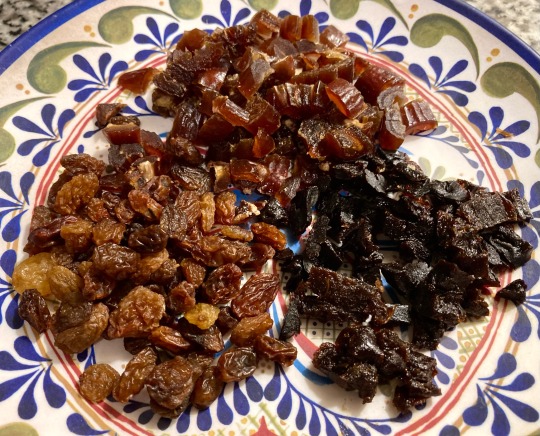
Instructions
1. Submerge wheat in water and scrub between your hands to clean and remove excess starch. Drain and cover by a couple inches with hot water. Cover and leave overnight.
2. Drain wheat and add to a large pot. Add water to cover and simmer for about 30 minutes until softened, stirring and adding more hot water as necessary.

Wheat before cooking

Wheat after cooking
3. Add dried fruit, sugar, salt, and spices and simmer for another 30 minutes, stirring occasionally, until wheat is very tender. Add water as necessary; the pudding should be relatively thin, but still able to coat the back of a spoon.
4. Remove from heat and stir in rosewater and honey. Ladle pudding into individual serving bowls and let cool in the refrigerator. Serve cold decorated with nuts and pomegranate seeds.
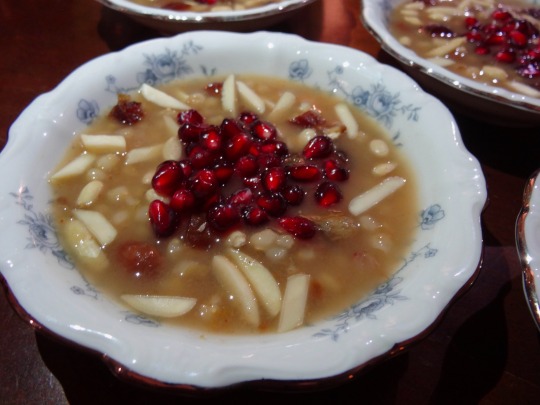
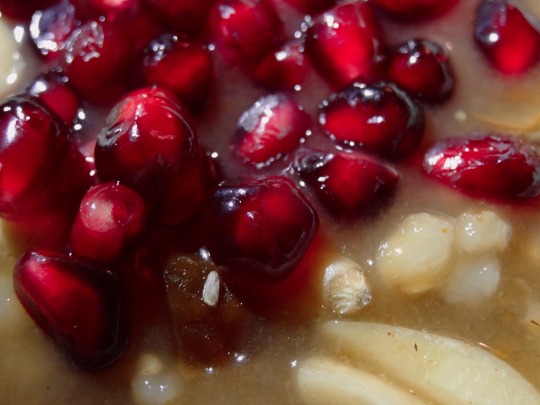
#the last link is a different / new fundraiser#Armenian#Palestinian#fusion#wheat berries#pearled wheats#pomegranate#prunes#dried apricot#dates#long post /
376 notes
·
View notes
Note
. . .Osiris
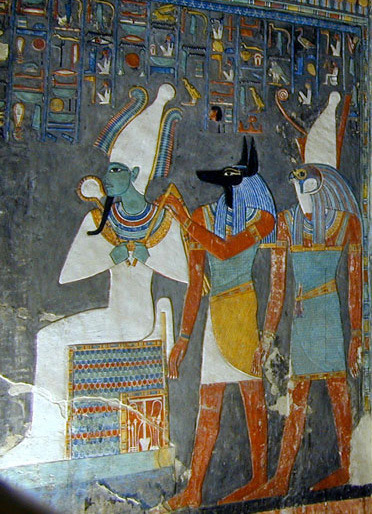
Osiris (Great and Beautiful is He) is the God of the Underworld; its King and Pharaoh ruling over the Duat. He is pictured here on the far left, His skin green and His body in mummiform. This is commonly how He is depicted; as a green-skinned, mummified man.
Son of Nut, the Sky Goddess, and Geb, the Earth God, Osiris was the first King of Egypt in accordance with Kemetic mythology, although there are stories that recount Geb, His father, being King before Him. There are a great deal of myths and stories that surround and involve Osiris, and I suppose it is important to at least skim over them before discussing hard facts about Him, as it gives some reference as to who He is and what the culture surrounding Him is like.
Osiris Myth
After the world was created, the Demiurge (who changes according to myth, and can be Neith, Ra, Amun, Ptah, or others) produces children; in the most popular form of this creation story, it is usually Ra who births the first Gods. They are Shu and Tefnut, Air and Moisture. Shu and Tefnut then form a union and birth two children of Their own: Nut and Geb, Sky and Earth. Nut and Geb were very much in love and refused to separate from each other, which, of course, caused a problem, because if the sky and the earth are eternally in contact, there is no space for anything to live and walk upon the earth. Ra made it so Nut and Geb were forever separated, by having Shu, air, stand atop Geb and hold Nut up as the sky. But Nut was already pregnant. When Ra discovered this, He was enraged, and forbade Nut from ever giving birth on any day of the year.
Nut cried to Djehuty (Thoth), and Thoth devised a plan. He went to Khonsu, God of the Moon, and set up a gamble, saying that every round of the game Senet Khonsu lost, He would have to give Nut some of His moonlight. Khonsu ended up losing so many times that Nut had enough moonlight for five days––five days that weren't in the calendar. This allowed Her to give birth on those five days, and on each day She had a different child; Ausir (Osiris), Wr-Heru (Horus the Elder), Sutekh (Set, Seth), Auset (Isis), and Nebet-Het (Nephthys). Nut and Geb were still forever separated by atmosphere (Shu), but the five Gods were birthed, and Osiris, as the eldest son, became King of the Living World.
As a side note, all Gods do have ancient Egyptian names which are different from Their Greek and now modern names. For convenience's sake, and to avoid confusion, I will use the names They are most known by; Their Greek/modern names. And as another side note, there are a lot of variations on this story. I will be piecing together a lot of different ideas but I will be leaving some things out for the sake of cohesion.
When Osiris came to Egypt, He found the people there to be chaotic and lawless. As King, He instituted laws and spread ma'at, which is truth, justice, harmony, and order. Egypt flourished under His rule and the people were incredibly happy, as all were equal, and with the fertility of the God-King, the crops were always bountiful and food was plenty. He brought not only law and prosperity, but also the right way to worship, and the teachings of agriculture.
Set, God of chaos, confusion, the desert, and of foreigners, and the youngest brother of the Ennead, grew to be quite jealous of His older brother. There are many variations and the most popular variation of this story comes from the end of the New Kingdom (1550-1070 BC), where Set fashions a fabulous coffin in the perfect measurements of Osiris, throws a party, and tells the party-goers that whomever the coffin fits may have the coffin as a gift. When Osiris fits perfectly, Set quickly shuts and bolts the coffin and throws it in the Nile (this version of the myth gives an origin to the idea that people who drowned in the Nile were holy). His coffin drifts downstream and into the Mediterranean, where it washes ashore in Phoenicia, in Byblos. The coffin wedges itself into a growing tamarisk tree, a tree which envelops the coffin. Eventually the tree is cut down and used as a pillar in the palace in Byblos.
Isis, Osiris' wife and sister, searched far and wide for Her husband, and did eventually find Herself in Byblos. The story is quite long and complicated, but in the end She convinced the King to give Her the pillar, and when she returned to Egypt, She hid Osiris in a swampy area of the Nile delta, and bade Her sister, Nephthys, to watch over Him while She went in search of healing herbs. But Seth heard that Osiris was back, and so after interrogating His sister-wife, Nephthys, He found Osiris, cut His body into pieces, and threw them into the Nile.
Isis was horrified at what transpired in Her absence, but She immediately set to work on finding the many pieces of Her husband with the help of Her sister, Nephthys. They managed to find every piece of His body except His phallus, which had been eaten by an oxyrhyncus fish, a fish that was thus forbidden to eat.
With the pieces of Osiris reassembled, and the healing powers of Isis in full power, Osiris was brought back to life, but incomplete. Isis assumed the form of a kite, and from above drew out the seed of Osiris, impregnating Herself with Their child: Horus the Younger. But Osiris, still incomplete, could not properly rule over the land of the living any longer.
This is why He is the ruler of the dead––He was once the king of the living, was killed, and was resurrected, and this is what every ancient Egyptian expected and hoped would happen to them: that they would die and be resurrected. In tombs and mortuary temples you will always see Pharaohs associating themselves with Osiris.
But this long myth I have just told you is not the only version of the story, and in my opinion, it is definitely the longest version of the story. Back in the Old Kingdom and Middle Kingdom there were several different versions; for example, Set's motive is different, ranging from revenge for Osiris kicking him, to revenge for Nephthys (Seth's sister-wife) sleeping with Osiris (which eventually births Anubis). Some texts claim that Seth took on the form of a wild animal, such as a crocodile or a hippopotamus, and killed Osiris that way. In others, Osiris is drowned. In some, the steps surrounding the coffin are skipped, and Osiris is simply cut up, and His pieces scattered around Egypt; a version which explains the many cult centers of Osiris claiming to be a place where Osiris is buried. Osiris' resurrection is also often helped along by other Gods such as Thoth (God of wisdom) and Anubis (God of embalming). In some versions, Set is killed for His actions. In most He is simply defeated and driven from the land, as chaos is necessary for balance and harmony, and thus cannot be killed. And the story that I have told is from the Late Period, recorded by Plutarch, and does not really go along with many Egyptian accounts, which often find Osiris' penis intact.
So that is the Osiris myth with all of its' intricacies and changing rhythms over the course of 4,000 years of Egyptian history. It embodies a huge amount of cultural practices and religious ideas within ancient Egypt, including the idea of truth, harmony, and justice, as well as resurrection, the afterlife, healing, and the workings of the cosmos. I've decided to leave out the later parts involving Osiris' son, Horus, and His fight with Set, for now because this does not directly involve Osiris, and that is our topic for this post.
Tradition, History, and Culture
Worship of Osiris dates back to the Old Kingdom, but the idea of Osiris is likely older than this. Before Osiris was actually Khentiamenti, an agricultural God centered in Abydos, a city which would later become the cult center of Osiris. Khentiamenti means 'Foremost of the Westerners', a title for the ruler of the dead, as the dead resided in the west, where the sun set each day. But Osiris Himself is not found mentioned in any texts or carvings until the 5th Dynasty, where He is depicted as a man wearing a divine wig. Later on He would take on the form we know Him best in––wrapped in a white mummy shroud, wearing an atef crown with ostrich plumes on the sides.
The mummy shroud He is depicted in forever associates Him with death and with the essential story behind Him, which is why I found it so important to start off with the Osiris Myth. This myth is also why He consumed and took the place of Khentiamenti; the name Khentiamenti, Foremost of the Westerners, instead became a title for Osiris as the King of the blessed dead. Another common epithet/name of Osiris is Wennefer (Omnophris), meaning 'The Beautiful One', 'The Beneficent One', and more archaically, 'One Whose Body Did Not Decay'. Among these names He was also called 'The Lord of Love', 'The King of Living', and 'The Eternal Lord'. From the Early Dynastic Period up until the end of the Ptolemaic Dynasty, when Rome conquered Egypt, Osiris was one of the most highly worshipped and revered Gods of Egypt.
Osiris was associated with the Nile river, with its' renewal and life-giving abilities, as one of Osiris' domains and powers was fertility, as well as rebirth. Another of His duties, evidence of which originates in the New Kingdom, was to act as judge of the dead; being King, He sat on the tribunal with the 42 Judges in the famous Weighing of the Heart ceremony. In this ceremony, which took place in the afterlife, the deceased would have to stand before the court and place their soul up for judgement. If it weighed lighter than the feather of Ma'at, representing all justice, truth, and harmony, then the heart acted well in life and would be allowed eternal happiness in the Field of Reeds. If not, the heart, and thus the person, would be consumed by Ammit and committed to nothingness. So Osiris would sit in on this tribunal and judge who entered His kingdom, as it was His domain. In this role, and in His role as King of the Living, as well, He was the embodiment of harmony, law, and justice.
"Most of his appeal was based on his embodiment of the cosmic harmony. The rising Nile was his insignia, and the moon’s constant state of renewal symbolized his bestowal of eternal happiness in the lands beyond the grave. In this capacity he also became the model of human endeavors and virtues..." (The Complete Gods And Goddesses Of Ancient Egypt, p.307)
As I mentioned earlier, Abydos became His cult center, as it was the cult center of the God who came before Him, whose traits He subsumed. It became a very popular burial site, as legends would say that Abydos was where Osiris was truly buried, and the people wanted to be buried as close as possible to Osiris. At one point they believed an ancient tomb there––which was actually the tomb of an Early Dynastic King––to be the tomb of Osiris, which they much revered, and left so many offerings in clay pots that Arabs would later call the site 'Umm el Qa'ab'; Mother of Pots. But this was not the only burial site of Osiris; since many variations of the myth include Set chopping up and dismembering Osiris into many parts, ranging from 14 to 42 different parts. These parts were scattered across Egypt, so many cities and nomes could claim that they had a part of Osiris buried in their domain. For example, far in the south, the island of Bigah claimed to be the burial site of Osiris' left leg, and thus the source for the yearly Nile inundation.
Going back to the Osiris Myth, after Osiris died and became the ruler of the dead, His son took His place as King of the Living: the falcon God, Horus (Heru the Younger). After the brief bout of chaos brought about under Set's rule, Horus took over (after much deliberation from the Gods) and order was restored. Because of this story, Pharaohs would not only associate themselves with Osiris in death, but with Horus in life. Each Pharaoh, as they came to the throne, would become the living embodiment of Horus on earth, the son of Osiris. In this way, Isis was also the mother of every Pharaoh, and their protector. And, to added extent, each Pharaoh would have a personal name, and then a Horus name granted to them when they ascended to the throne.
"It is for this reason that Osiris is so often depicted as a mummified pharaoh; because pharaohs were mummified to resemble Osiris. The image of the great mummified god preceeded the practice of preparing the royal body to look like Osiris... The king's appearance as modeled after Osiris' extended throughout his reign; the famous flail and shepherd's staff, synonymous with Egyptian pharaohs, were first Osiris' symbols as the flail represented the fertility of his land while the crook symbolized the authority of his rule." (Osiris, World History Encyclopedia, Joshua J. Mark)
Osiris can also be represented by a number of physical symbols, such as the crook and flail that He carries in almost all representations of His earthly form. The crook, which is the striped hook He carries, represents power/authority, and is a symbol of the Pharaoh. The flail, which is the instrument in His other hand, represents the fertility of the Nile, and as an extension, the fertility of Osiris Himself. But the crook and flail, though both seen typically as symbols of Pharaonic power, are actually the tools of a shepherd. There is reasonable evidence, thusly, to suggest that the physical origins of the idea of Osiris may not be that of a great King, but of a ruler of a shepherd tribe in the Nile Delta, whose rule was so beneficent that it led to him being worshipped as a God. For Egyptologists, this theory comes from His association with Andjety, a predynastic God-King worshipped in the Delta who also bore the crook and flail as His symbols. This, however, has not and likely cannot be fully proven. But the postulation is still interesting nonetheless!
Osiris' ba soul had its' own culture of worship, a practice of soul-worship that is prevalent in the cults of several other Gods, such as Hathor (HwtHer). In this form, Osiris was known as Banebdjedet, meaning 'The Ba of the Lord of the Djed,' which in English terms means 'The Soul of the Lord of the Pillar of Continuity', as ba means soul, and djed is the symbol for a pillar, which represented the backbone of Osiris. Interestingly, the name Banebdjedet is feminine, as the letter t denotes a feminine word or name in ancient Egyptian; although there are also variations on this name that exclude the t in favour of the alternative, Banebdjed. Banebdjedet, Osiris' ba soul, was worshipped mainly in Mendes, a city in Lower Egypt, in the Delta.
This leads to an interesting point concerning the androgyny of Osiris, a subject I found while researching for this post. Osiris' fertility comes from His castration and then being healed by the mother Goddess, Isis. Not only that, but both men and women identified themselves with Osiris in death. Then the name for His ba personified as another God is feminine, although representations of Banebdjedet are overwhelmingly male. Before anyone attacks me, I am not claiming that Osiris is a genderless God or King––just that He has some traits of androgyny, which I find interesting and love to study in ancient cultures, and I thought it would be good to mention for anyone else similarly interested.
Worship, Festivals, and Cult Activities
When it comes to the practices surrounding Osiris' cult, we actually know a good deal of information regarding the activities of worshippers and priests. Osiris' cult and worship was so widespread and lasted long enough that it could be recorded by the earliest Greek historians, and remained carved in temple walls for thousands of years. Among the most well-known cultic tradition is the Osiris Bed.
The Osiris Bed is rather well documented, as it was an object placed in tombs. It was not a bed for the deceased to lie in, but instead a box made of wood or clay, moulded into the shape of Osiris, in which the fertile Nile soil was placed and seeds were planted. These boxes were then wrapped in white mummy linens, and the seeds sprouted through, representing the resurrection and fertility of Osiris, and the crops that grew each year in cycles. One of the most famous of these beds was found in King Djer's tomb, a King from the Early Dynastic Period; the 2nd King ever of the unified Egypt. Coincidentally (or, perhaps, not so coincidentally) King Djer's tomb was the tomb which pilgrims believed to be Osiris' burial site.
While the Osiris Bed is far from the only practice and tradition of the Osiris cult, it does show the rich cultural practices and symbolism present in His worship. Let's look at some other examples of the practices of Osiris' cult.
Similar to the Osiris bed were Osiris gardens, which were essentially the same concept; fertile soil was planted inside a vessel shaped into the form of Osiris, and seeds were settled within to grow. These beds were tended to during festivals instead of being buried in a tomb.
There were a great many festivals, and each of them quite popular according to their time period, dedicated to the story and symbolism of Osiris. Some festivals started with recounting the mournings of Isis and Nephthys, Osiris' sister-wife and sister, in the form of a drama acted out in a call-and-response format. Another drama acted out for the glory of Osiris was more in the form of an actual fight that anyone could participate in; it was modelled after The Contendings of Horus and Set, which I briefly mentioned as a long and drawn-out argument between Horus and Set over who deserved Osiris' vacant throne after He had died. On this occasion, people would battle out and reenact the events of the story until the side of Horus finally won and victory was achieved. Afterwards, the celebrations commenced in honoring the restoration of order, and the gold-encased shAwyt-nTr (the Holy Statue) of Osiris would be taken out and lavished with offerings. Osiris, in the form of this statue, would be paraded throughout the city of Abydos before being placed in a shrine outside, where He could participate fully in the festivities, and be admired by the commoners who would usually never behold the face of Osiris. This emergence of Osiris from the dark temple's inner sanctuary to the light of the city resembled and represented His resurrection from death into life again. Although this particular festival was celebrated mainly in Osiris cult center of Abydos, it was also celebrated in other cities such as Bubastis in the Delta, Busiris, Memphis, and Thebes, in Upper Egypt.
The Mysteries of Osiris was a series of plays performed annually, and in dramatic, passionate form. It was one of the most popular observances of worshippers, and it told the story that I first told to you––of Osiris' life, His death at the hands of His brother, His resurrection at the hands of His sister-wife, and His ascension into the role we now know Him for. The roles in this reenactments were often taken up by high-ranking officials, and afterwards, the Contendings of Horus and Set would take place, which I just mentioned. These plays would take place over several days.
One festival was called The Fall of the Nile. During this time, the waters of the Nile would recede, and the worshippers of Osiris would go into mourning. One of Osiris' representation on earth was the Nile, and the Nile represented His fertility and life.
Another festival was celebrated on the 19th day of Pakhons, one of the months in the Egyptian calendar, which is roughly equivalent to May in our Gregorian calendar. On this day, the followers of Osiris would go to the river with shrines containing vessels of gold and metal, and would pour water into the Nile, exclaiming, "Osiris is found!" Mud and spices were mixed and moulded into the shape of Osiris, as well, to celebrate His return. Another festival similar to this one was called The Night of the Tear, and took place during modern-day June.
The last festival pertaining to Osiris that I will mention is the Djed pillar festival, held in modern-day January. The Pharaonic court and family would participate, raising djed pillars to welcome Osiris and the harvests that coincided with His return.
One last and interesting tradition that may seem familiar to Christians, at least in a small way, was the baking of bread in the shape of Osiris; bread as the flesh of the God, a sort of predecessor of communion wafers. But in reality the traditions of the Osiris cakes are completely different, and there were several different ways of going about it, depending on which nome you were from. In Dendera, wheat-paste models were made in the shape of each of the 16 dismembered parts of Osirs, and each model was sent out to the town where each respective part of Osiris was found by Isis. In Mendes, figures of Osiris were made of wheat and paste. On the day of the murder, they were placed in a trough, followed by water being added each day for several days. Afterwards, this mixture was kneaded into a dough, put into a mold of Osiris, and buried on the temple grounds.
Conclusion
This has been a somewhat brief glimpse into the cult, history, and traditions surrounding the Great God, The Beautiful Lord Osiris. If I can clarify anything please let me know and I will do my best!
#Osiris#ancient egypt#egyptian mythology#egyptian gods#Kemetic#ancient history#egyptology#Kemeticism
238 notes
·
View notes
Note

perhaps journalist Anthony geeking over how he somehow got supermodel Kate Sharma to be his wife ?
Journalist Anthony is absolutely… insane confused and befuddled about why one of the most beautiful women in the world agreed to date him, let alone the fact that they’re married.
He stands off the side the of her shoots, watching her work. and he stands back when they got to film premieres and fashion week, Watching people clamor for her attention. Watching as she tells other young girls how beautiful they are. How they don’t need to change for that.
“No offense, you’re a handsome guy,” Benedict mused one day as he watched Kate taking a photo with someone who’d asked for it as they left. “But how the hell are you married to that woman?”
Anthony laughed, “None take. There are millions of men who’d cut off their arm if it meant Kate Sharma would flirt with them. I’m not even a hold over from before she was famous who keeps her grounded which is the confusing thing. I’m just… she’s clearly insane though to be fair. She actually thinks she’s the lucky one.”
“I could do worse than you.” Kate laughed, kissing him quickly as she caught the tail end of their conversation. “I thought you were flirting with me at first anyway! Why else would you tell me you kept a calendar of me around?!”
“I panicked! I thought you would be mean and I didn’t know what to do! I didn’t expect insightful commentary!”
“More fool you, Anthony.”
“I was startled! You can’t just smile at men without warning, Kate. The Ancient Greeks used to fight wars over women who smiled like you did!”
Kate peered at Benedict, “I literally never thought I’d be married to a man desperate to tell me so much about the Trojan war but here we are. He’s cute when I tell him I loved the movie Troy.”
“It’s just not accurate, Kate! It’s not!”
131 notes
·
View notes
Text
☽◯☾₊‧⁺˖⋆ Goddess Worship: An Introduction of Hekate ⋆˖⁺‧₊☽◯☾
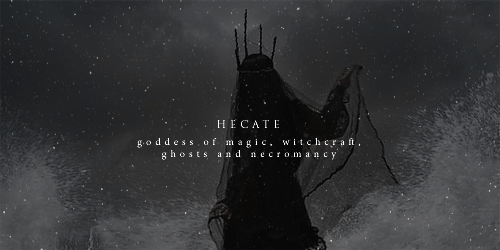
Note: Hey guys. I am indeed very late for the calendar but. life lately has been erratic and complicated. Today we have the last introduction of deities I work with/worship. This post is to provide some information about the deities but also how I work with them personally. Everyone has their own methods with the Gods, and you should do whatever feels right with you while also respecting the bases of the religions.
─── ⋆⋅☆⋅⋆ ───── ⋆⋅☆⋅⋆ ───── ⋆⋅☆⋅⋆ ───── ⋆⋅☆⋅⋆
Historical Background:
Hecate (or Hekate) is a goddess from the Greek pantheon associated with magic, witchcraft, the moon, night, necromancy, and crossroads. Her origins are debated, but she appears in Greek mythology as a powerful and ancient deity, sometimes associated with the Titans or as a daughter of the sky god Perses and the star goddess Asteria. She is also linked to the pre-Greek civilizations, potentially from Thrace or Asia Minor, where her worship may have originated based on the most recent archeologic studies. As the deity of crossroads with the power of navigating between worlds, we find several counterparts on other mythologies/religions: Exu, Papa Ledga, Janus, Odin, Hubal, ect

Atributes and Symbols:
Torches: Hekate is often depicted holding two torches, symbolizing her ability to illuminate the unseen or unknown. Hekate is the goddess of magic, she is believed to be able to cross both the dead and living realm Keys: Mostly linked for her to be a guardian and also to hold secrets. Dogs: Dogs are sacred to her, especially black dogs who seem to be her loyal companions Snakes: they symbolize her connection to the underworld. Crossroads: Hekate is associated with the liminal spaces where three roads meet, symbolic of her power over transitions and the boundaries between worlds. Moon: Her magic is tied to the moon phases, which is why most people who worship her will perform rituals during the moon phases.

Worship and Rituals:
Deipnon: The Hekate's Deipnon was a monthly offering made at each new moon, where supplicants left food offerings (bread, cheese, eggs, garlic, and fish sometimes wine as well and basically what they had to offer in her honor) at crossroads to appease her and ask for her protection. Crossroads Shrines: Small shrines or altars to Hekate were frequently placed at the boundaries of homes, gardens, or towns, especially near crossroads. Worshipers would leave sacrifices like incense, honey, and eggs. Witchcraft and Magic: Hekate is invoked in spells, particularly those related to protection, divination, necromancy, and curse work. Her role as a liminal goddess gave her the power to grant access to the underworld and the unseen forces. However Hekate is a very strong presence and not for begginers as your spells can turn against you if you aren't experienced enough.

-> When worshipping Hekate, it is fundamental to make offerings during every moon phase to apease her energy and allow it to flow through you during your spells. An altar/shrine is mostly necessary if you want to work with her. Offerings can be given to her at her altar for three days before you can remove them and dispose of them in a crossroad for the wandering spirts.
-> Ideas for offerings: Wine, honey, bread, garlic, fish, eggs, keys, snake symbols or dogs symbols, blood, crystals tarot cards, prayers

BIBLIOGRAPHY:
"Greek Religion" by Walter Burkert "Hekate: Liminal Rites" by Sorita d'Este and David Rankine Marquardt, P. A. (1981). A Portrait of Hecate. The American Journal of Philology, 102(3), 243–260. https://doi.org/10.2307/294128 Boedeker, D. (1983). Hecate: a transfunctional goddess in the Theogony?. Transactions of the American Philological Association (1974-), 113, 79-93. Daşbacak, C. (2008). Hecate cult in Anatolia: Rituals and dedications in lagina. Anados 6-7/2006-2007 Studies of the Ancient World
112 notes
·
View notes
Text
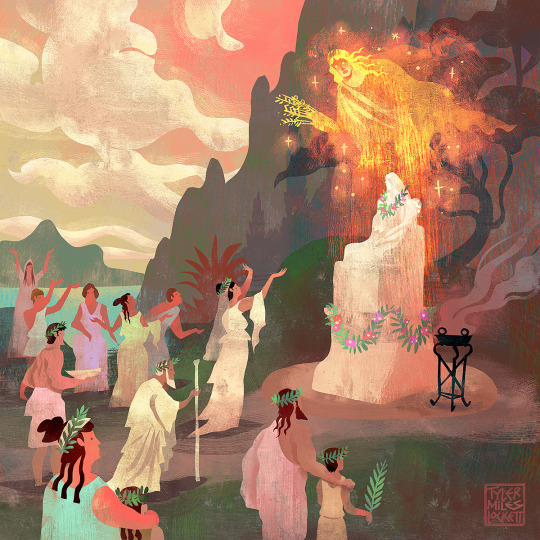
Hellenic Polytheism or Hellenismos is the traditional, polytheistic (multiple gods) religious belief system of Ancient Greece. Modern people who believe in pre-Christian and polytheistic belief systems often refer to themselves as pagans. Let’s look at some of the general practices of typical Hellenic worship.
Hellenic Polytheists use altars or shrines to worship specific Gods within the Greek Pantheon. For example, an altar for Apollo may contain an image or sculpture bust of the god, as well as a side table, called a trapezōmata, which holds offerings of incense and flowers or food and drink such as wine, honey, milk, or olive oil. Another tripod incense holder was called a Thymiateria.
Before engaging in a ceremony, the practitioner will employ purification methods with lustral water (ritually cleansed). They may recite hymns or prayers in honor of the god, using the Homeric hymns for example. The practitioner may use a divination practice to seek guidance or gain insight from a god through methods like casting lots, reading signs from nature, oracle prophecies, and dream interpretations. In their ceremonies, ancient Greeks would perform rites in respect to their Ta Patria, (ancestral homeland heritage), and they would take pride in their reverence with Hos Kallista, or the highest level of beauty.
Hellenic Polytheism follows annual calendar festivals commemorating Gods or famous mythological events such as the Panathenaia in Athens (commemorating Athena), the Anthesteria and City Dionysia; (festivals celebrating Dionysus) The Olympics (a physical competition in honor of Zeus) and the Thargelia, (dedicated to Apollo and Artemis), and the Thesmophoria, (a festival exclusive to women in honor of Demeter), among many others.
Want to own my Illustrated Greek myth book jam packed with over 130 illustrations like this? Support my kickstarter for my book "lockett Illustrated: Greek Gods and Heroes" coming in October.You can also sign up for my free email newsletter. please check my LINKTREE:
#pagan#hellenism#greek mythology#tagamemnon#mythology tag#percyjackson#dark academia#greek#greekmyths#classical literature#percy jackon and the olympians#pjo#homer#iliad#classics#mythologyart#art#artists on tumblr#odyssey#literature#ancientworld#ancienthistory#ancient civilizations#ancientgreece#olympians#greekgods#zeus#hesiod
578 notes
·
View notes
Text
I made a new Advent Calendar. This time it’s got Ancient Greek Women of Myth in it - behind each door is a representation in lineart and digital watercolour of one of the mortal* women from Ancient Greek mythology. Some are from my back catalogue, some are from ClassicsTober, and quite a few are brand new for this calendar.
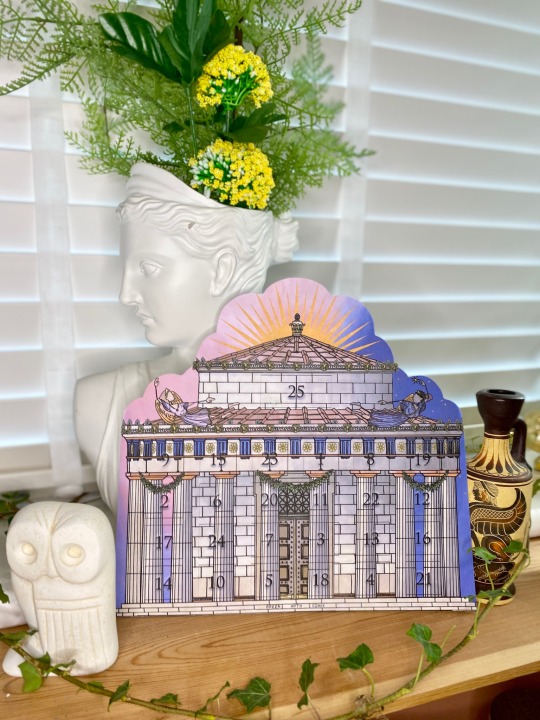

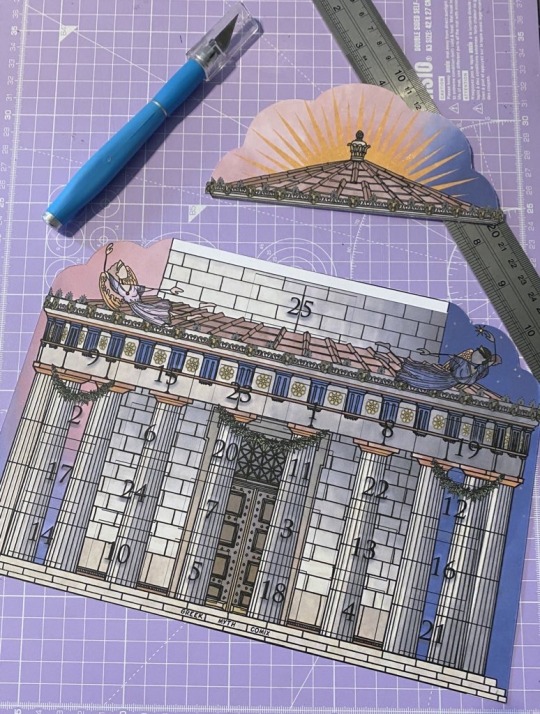
Somehow, I’ve already sold out the 50 order slots 🥰
I’m making a PDF version to put out probably at the end of the week, so you can make your own at home. It’s not too hard, just a lot of cutting! It will be with the rest of my download-and-print stuff on the http://greekmythcomixshop.wordpress.com website.
#advent#advent calendar#ancient greek advent calendar#alternative advent calendar#greek mythology#tagamemnon#greek myth#illustration#greek myth comix#comix#illustrator#ancient greek mythology#women of mythology#women of myth#Ancient Greek women
12 notes
·
View notes
Photo

The ancient Olympic Games were a sporting event held every four years at the sacred site of Olympia, in the western Peloponnese, in honour of Zeus, the supreme god of the Greek religion. The games, held from 776 BCE to 393 CE, involved participants and spectators from all over Greece and even beyond. The Olympic Games were the most important cultural event in ancient Greece and they ran for 293 consecutive Olympiads. So important were the Games in the ancient world that they were even used as a basis for the calendar.
110 notes
·
View notes
Text
One Poem a Day: September
"beautiful" words related to September for your next poem/story

September - ninth month of the Gregorian calendar. Its name is derived from septem, Latin for “seven,” an indication of its position in the early Roman calendar.
Apple-polish - to use flattery or the doing of favors in order to win approval especially from a superior
Anecdotage - the telling of anecdotes (i.e., a usually short narrative of an interesting, amusing, or biographical incident)
Ardency - depth of feeling
Auburn - of a reddish-brown color
Autumnity - quality or condition characteristic of autumn
Bucolic - of, relating to, associated with, or typical of open areas with few buildings or people; idyllic
Cathexis - investment of mental or emotional energy in a person, object, or idea
Ceres - the Roman goddess of agriculture
Churn Supper - a feast at the end of the hay harvest
Cider - fermented apple juice often made sparkling by carbonation or fermentation in a sealed container
Cornucopian - being more than enough without being excessive
Demeter - the Greek goddess of agriculture
Effulgence - radiant splendor; brilliance
Estivo-autumnal - relating to or occurring in the summer and autumn
Felicific - causing or intended to cause happiness
Fête - a lavish often outdoor entertainment
Gemütlich - agreeably pleasant; comfortable
Georgic - a poem dealing with agriculture
Harvest - the season for gathering in agricultural crops
Hearthstone - the place where one lives
Husbandry - the cultivation or production of plants or animals
Moon (away) - to spend in idle reverie; dream
Odeum - a small roofed theater of ancient Greece and Rome used chiefly for competitions in music and poetry
Prosaic - being of the type that is encountered in the normal course of events
Reposeful - of a kind to induce ease and relaxation
Rubicundity - ruddy (i.e., having a healthy reddish color)
Sapphire - a gem variety of corundum in transparent/translucent crystals of a color other than red; a deep purplish-blue color
Surfeit - an intemperate or immoderate indulgence in something
Torridity - parched with heat especially of the sun; hot
Victual - to supply with food
Sources: 1 2 3 ⚜ More: Word Lists
If any of these words inspire your writing, do tag me or send me a link. I'd love to read your work!
#word list#september#writing prompt#dark academia#spilled ink#writeblr#writers on tumblr#poets on tumblr#poetry#literature#langblr#linguistics#words#light academia#lit#autumn#writing inspiration#writing ideas#writing inspo#creative writing#writing reference#rene magritte#surrealism#landscape#nature#moon#writing resources
103 notes
·
View notes